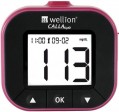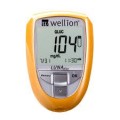Measuring duration
The measurement time of a blood glucose monitor is the duration from inserting a test strip with a blood sample into the device to receiving the result. While a shorter measurement duration theoretically enhances convenience by reducing the time spent on measurements, most modern blood glucose monitors complete this process in under 20 seconds, causing minimal inconvenience. Therefore, seeking the fastest model may not be particularly meaningful in practical terms.
Memory capacity
The maximum number of test results that a blood glucose monitor can store at once is crucial for monitoring changes in blood composition. The built-in memory of blood glucose monitors is highly convenient, automatically saving data without requiring extra steps from the user. Additionally, many devices can enhance measurement results with supplementary information, including date, time, and food markers.
Knowing the frequency of measurements and the amount of memory, you can determine how long this memory will last before overflowing. For example, if the device is designed for 500 results, and measurements are taken 4 times a day, then measurements can be stored in the built-in memory for 500/4 — 125 days, that is, about 4 months.
Measurements
Blood parameters that the blood glucose monitor can measure.
—
Glucose. Measuring blood glucose levels. It is this measurement that is colloquially called "measurement of sugar levels." There are other types of sugars in the blood, but it is the level of glucose that is the key physiological parameter. This function is the main one for glucometers and is supported by all models by definition.
—
Cholesterol. Measuring blood cholesterol levels is crucial because cholesterol and its derivatives play a significant role in metabolism. Elevated levels of "bad" (low molecular weight) cholesterol pose a risk of atherosclerotic disorders, including plaque deposition in vessels, reduced lumen, and an increased likelihood of heart attack or stroke. This measurement is especially important in the context of diabetes, as it often coincides with increased blood cholesterol levels.
—
Ketones. The capability to measure blood ketone levels is crucial, especially in conditions of insulin deficiency, as ketones can lead to deterioration of well-being when glucose levels are high. Even a slight increase in ketones can cause symptoms like irritability, nausea, vomiting, abdominal pain, and tachycardia. At critical levels, it can lead to ketoacidosis, a severe and life-threatening condition. Notably, ketone levels are not directly correlated
...with blood sugar levels—they can be elevated with both high and low glucose. For diabetics, monitoring ketone levels is essential in certain situations. While the traditional method involves urine analysis using special test strips, modern blood glucose monitors can now measure ketone levels simultaneously with glucose levels, eliminating the need for separate measurements.Averaging
Options for averaging results provided in the blood glucose monitors.
Averaging is the derivation of the average measurement result (primarily the average glucose level) over a certain period. The need for such calculations is due to the fact that with individual measurements, the indicators are affected by momentary factors, while the general trend must be determined by average numbers. In modern blood glucose monitors, averaging can be provided for different periods — from 1 day to a quarter.
Sample volume
The minimum amount of blood required for testing. The average volume of a drop of blood released when pricked with a lancet is 1 µl; that is, if the sample volume is larger, a little more blood will need to be squeezed out.
Note that in fact, the volume can be taken with a margin — most blood glucose monitors work normally even with more blood than necessary. But too little material leads to serious inaccuracies in the readings, so this parameter should not be neglected.
Hematocrit
The hematocrit values for which the device is designed.
Hematocrit reflects the overall red blood cell count in the blood, influencing blood viscosity and electrochemical properties. Glucometers are calibrated for specific hematocrit ranges. When these limits are surpassed, inaccuracies arise — low hematocrit levels can lead to device overestimation, while high levels can result in underestimation.
Modern blood glucose monitors typically have a hematocrit range of 30 – 50%, which effectively encompasses normal adult blood viscosity values (36 – 48%). Issues may only arise in cases of significant deviations from the norm. Some devices offer an even broader operating range.
Features
—
Food note. The feature to annotate measurement results with information about the timing, specifically whether the analysis was conducted before or after a meal, is valuable. Devices with this capability can not only add notes to results but also gather separate statistics, such as averaging, for each result type. This method of data collection is considered optimal because glucose levels before and after a meal are distinct parameters with unique characteristics.
—
Date and time. The presence of a built-in clock and calendar in the blood glucose monitor. This function is intended mainly to record the time and date of each measurement — an indispensable function for collecting statistics. However, information about the time and date can be useful for purely domestic purposes.
—
Alarm clock. Classic alarm clock — a sound signal given by the device at a specified time. In glucometers, this function is intended not so much for getting up in the morning (although it can be used for this purpose), but to
remind you that the time has come to take another measurement.
—
Voice notification. Blood glucose monitors with voice capabilities can audibly announce measurement results and may offer other functions through the built-in speaker. This feature is particularly beneficial for indivi
...duals with visual impairments who face challenges in reading the display.
— Synchronization with PC. The device's ability to sync with a computer, typically through USB connection, allows for the transfer of collected data since the last synchronization. A specialized application on the computer processes this data, offering more extensive functions than the device itself. These may include daily graph plotting, identifying minimum and maximum values, averaging for specific periods (refer to the relevant section), and facilitating data transfer to the attending physician.
— Backlight. The presence of a backlight in the display of the device allows you to read readings from it in low light conditions — up to complete darkness. The backlight can turn on automatically or by pressing a special button.
— Alert. An audible alert signals users when certain blood parameters reach critical levels, particularly designed for individuals facing health issues that impede reading the display (e.g., blurred vision). The alarm threshold is typically adjustable manually, tailored to individual cases and established in consultation with a doctor.
— Auto swicth-off. Automatic shutdown function after a certain period of inactivity. Provides battery saving and eliminates the need for the user to manually turn off the device; some models do not provide manual shutdown at all — only automatic. The auto-off time, usually, is several minutes — in such a way that the user can familiarize himself with the measurement results without fuss.
— Auto-ejecting test strip. Automatic ejection of the test strip: when the test is completed and the result is obtained, the device opens the holder, allowing the strip to fall out freely. In models without auto ejection, you usually need to press the appropriate button to remove the strip.Test strips
The number of test strips included with the blood glucose monitor.
Test strips serve as the primary consumables for blood glucose monitors, typically provided in sets of around 10 to 20 pieces, occasionally up to 50. Since each analysis requires one strip, and diabetes monitoring involves 2 to 8 daily measurements, the supplied strips are mainly for initial device testing and performance evaluation. Additional consumables will need to be purchased for regular use.
Test strip model
The test strip models that the blood glucose monitor is compatible with. This information is especially important in light of the fact that consumables must be purchased separately for continuous use (complete test strips are usually only enough for familiarization and initial testing). For normal operation of the device and reliable results, use only consumables recommended by the manufacturer.

